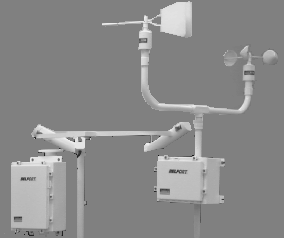AVIATION ROUTING WEATHER REPORT (METAR)
 |
Runway Visual Range Group
(RDRDR/VRVRVR
VRFT
or
RDRDR/VnVnVn
VnVVxVxVxVxFT)
|
Index
Definitions and Standards for observing and
reporting Runway Visual Range
Runway Visual Range (RVR)
The runway visual range is the maximum distance at which the runway, or
the specified lights or markers delineating it, can be
seen from a position above a specified point on its centerline. This value is
normally determined by visibility sensors located alongside and higher than the
center line of the runway. RVR is calculated from visibility, ambient
light level, and runway light intensity. It is common practice to use a
transmissometer or forward scatter meter as the RVR visibility sensor. A
transmissometer measures the transmittance of the atmosphere over a baseline
distance while a forward scatter meter measures the extinction coefficient of
the atmosphere. RVR is then derived from equations that also account for
ambient light (background luminance) and runway light intensity based on the
expected detection sensitivity of the pilot's eye.
Observing Positions
The location of the RVR visibility sensor should be
within 500 feet of the runway centerline and within 1,000 feet of the
designated runway threshold.
Day-Night Observations for Transmissometers
The day scale shall be used in
the evening until low intensity lights on or near the airport complex are
clearly visible. The night scale shall be used in the morning until these
lights begin to fade. Alternately, a day-night switch may be used to determine
which scale should be used.
Multiple Runway Visual Range Sensors
At automated stations where it is
applicable, RVR values for as many as four designated runways can be reported
for long-line dissemination. At manual stations, only RVR for the designated
runway shall be reported.
Units of Measure
RVR is measured in increments of 100 feet up to 1,000 feet,
increments of 200 feet from 1,000 feet to 3,000 feet, and increments of 500
feet above 3,000 feet to 6,000 feet.
Runway Visual Range Based on a Transmissometer
Ten-minute extreme values
(highest and lowest) of transmittance shall be reported. Manually reported
RVR shall be based on light setting 5 for either day or night time conditions,
regardless of the light setting actually in use. One RVR value shall be
reported if the ten-minute high and low value are the same.
Table A-5 summarizes the runway visual range observing and
reporting standards.
| Table A-5 Summary of RVR
Observing and Reporting Standards |
| RVR |
Observing and Reporting Standard |
| Number of RVRs |
Up to 4a |
| RVR Light Setting |
5 for transmissometer systems |
| When Reported |
When visibility less than or
equal to 1 statute mile
AND/OR
RVR less than or equal to 6,000 feet |
a. Manual Observations shall contain
only one RVR |
Coding and Decoding the Runway Visual Range Group
-
RVR shall be coded in the format, RDRDR/
VRVRVRVRFT, where R
indicates that the runway number follows, DRDR is
the runway number (an
additional DR may be used for runway approach directions, such as
R for right,
L for left, and C for center), VRVR
VRVR is the constant reportable value, and
FT indicates that units of measurement are feet. A solidus
"/" without spaces
separates the runway number from the constant reportable value.
For example,
an RVR value for runway 01L of 800 feet would be coded
- RVR that is varying shall be coded in the format,
RDRDR/VnVnVn
VnVVxVxVxVxFT,
where R indicates that the runway number follows,
DRDR is the runway number (an additional DR
may be used for runway approach
directions, such as R for right, L for left, and C for
center), VnVnVnVn is the
lowest reportable value in feet, V separates lowest and highest visual
range values, VxVxVxVx is the
highest reportable value, and FT indicates that units
of measurement are feet. A solidus "/" without spaces separates the
runway number from the reportable values. For example, the 10-minute RVR for
runway 01L varying between 600 and 1,000 feet would be coded
- The values shall be based on light setting 5 at manual stations
regardless of the light setting actually in use.
- RVR values shall be coded in
increments of 100 feet up to 1,000 feet, increments of 200 feet from 1,000 feet
to 3,000 feet, and increments of 500 feet from 3,000 feet to 6,000 feet.
- Manual RVR shall not be reported below 600 feet. For automated stations,
RVR may be reported from up to four designated runways.
- If the RVR is less than its lowest reportable value, the VR
VRVRVR
or VnVnVnVn groups shall be
preceded by M. If the RVR is greater than its
highest reportable value, the VRVRVR
VR or VxVxVxVx groups
shall be preceded by a P. For example, an RVR for runway 01L of less
than 600 feet will be coded
An RVR for runway 27 of greater than 6,000 feet will be coded
Note: ICAO standards indicate runway visual range is reported in meters
when visibility is less than 1500 meters. The designator i in the ICAO format
is the RVR tendency, either a U (for increasing) or a D (for
decreasing) if during the 10 minutes preceding the observation the runway
visual range showed a tendency to increase or decrease. If no change
occurred, it is omitted.
Return to First Page Index

